Jen Black's Blog, page 30
November 26, 2019
VIKING BRIDE ~ NEW RELEASE!
My new historical romance is released on Amazon Kindle today!
VIKING BRIDE is set in the Hebridean island of Lewis sometime around AD1040. It begins with the news that a marriage has been arranged that will break the hearts of two young people and force others into rash actions that have unsuspected consequences. There lots of action and excitement as well for those who like a little more than a love story.
Here’s the blurb ~It was a marriage no one wanted, least of all the bride. She knew the groom loved someone else. But how would you avoid a forced marriage? Arrange a swift abduction? An accident? What happens when a third party takes a hand in the game and changes everything?
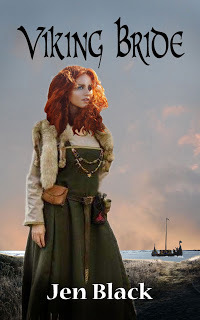 When chieftain Ragnar and his friend Grettir force the marriage on their offspring they have no idea of the powerful feelings they will unleash, nor the dreadful consequences that will follow. Set in the Hebrides in the eleventh century, when Christianity was taking hold in Viking communities settling down as farmers and neighbours, but the old familiar gods had not quite been forgotten.
When chieftain Ragnar and his friend Grettir force the marriage on their offspring they have no idea of the powerful feelings they will unleash, nor the dreadful consequences that will follow. Set in the Hebrides in the eleventh century, when Christianity was taking hold in Viking communities settling down as farmers and neighbours, but the old familiar gods had not quite been forgotten.
And heres's the cover:
In AD 1040 MacBeth was High King of Alba and the Vikings were settling down in various parts of Scotland as neighbours and farmers. Emerging facts about the Vikings over the last few years would have us see them as less than rampaging warriors anxious to lop off heads, and more as settled neighbours; but I think they would still be a dominant force in any area they chose to settle and very dangerous to those who dared to argue with them. Among themselves, I am sure they were as happy, miserable, compassionate, cruel, cynical, greedy, envious and bloody-minded as people everywhere can be today. How they managed to blend in with the local populations makes a fascinating story.

Northumberland nudges the border with Scotland and shares a good deal of its history. Ullapool is almost as close as London, and most of my holidays (apart from going to France in latter years) have been spent north of the border, including several in the Hebrides. I bicycled through the Uists one year when I was a good deal fitter than I am now, stayed in an old farmhouse in Arnol another year and various B&Bs throughout the islands later still. Got caught in a rainstorm on a gorgeous beach opposite Scarp and I can tell you it was a long, wet walk back to Hushinish!
I can’t say why I’ve always been interested in Scottish history, except that it began when I was about twelve with a book about ~ as you might guess ~ Mary Stewart. There is something in the air and the landscape of the west coast and the islands that resonates with me. A lady from Scotland turned up in my mother’s family tree about four generations back, but I really cannot blame it all on her! The land and the history simply proved more attractive to me than England and all those kings named Henry.
I have a degree in English and worked in academic libraries in the north east of England until retirement a few years ago. That’s when I began writing seriously and there are now twelve novels with my name on them – all historicals bar one. I hope you will enjoy my latest story and in the hope that you will, here are the links to follow:
My Facebook Author page: @JenBlackauthor My books are listed on Amazon Author Central: https://www.amazon.co.uk/Jen-Black/e/B003BZ8JNQ My blog is https://jenblackathor.blogspot.com. I would be delighted to see you at any or all of them!
Published on November 26, 2019 16:30
November 22, 2019
NaNoWriMo, I believe.
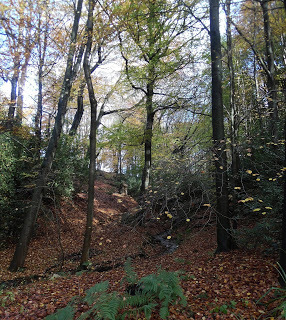 It is November.
It is November.Lots of people are tapping away at their computer to take part in the Write a Novel in a Month competition. I think it results in a drop in posts on social media, and a drop in stats on my blog. Everybody else's blog too, I suspect. (I wonder if this makes it a bad month to bring out a new novel?)
I have never tried to do the 50,000 words in a month and I don't think I ever shall. For me it would require so much editing afterwards that it would be more time consuming than usual.
Now that I have finished Viking Bride - and I have - both Kindle, published on 27th of this month and - cross my fingers and hope the proof looks all right when it arrives - the paperback, which might be a week or so later, I can take a deep breath and look around me.
I must do some PR work. It is so easy to forget, but it must be done. Otherwise no one knows I exist, and even less do they know my books exist. So in between dodging the rain during this miserable, flooded-fields November and washing Tim's paws every time we come back from a walk, I shall be busy exploring new ways of getting myself known. It has been a quiet month, with DH in Australia; just me and Tim.
Published on November 22, 2019 01:19
November 16, 2019
It was a marriage no one wanted
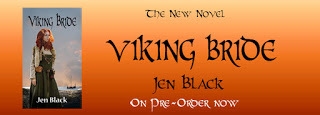 Here’s the blurb:It was a marriage no one wanted.Least of all the Borgunna and Asgeir.
Here’s the blurb:It was a marriage no one wanted.Least of all the Borgunna and Asgeir.When chieftain Ragnar and his friend Grettir force the marriage on their offspring they had no idea of the powerful feelings they would unleash, nor the dreadful consequences that would follow. Set in the Hebrides in the eleventh century, when Christianity was taking hold in Viking communities settling down as farmers and neighbours, the old familiar gods had not quite been forgotten.If any of you read Far After Gold then you will recognise Flane ~ he re-appears in this story as wedding guest and distant cousin of chieftain Ragnar.Find it here: https://tinyurl.com/wras6vg
Published on November 16, 2019 01:19
November 9, 2019
We're getting close now!
 Latest story is very close to publication.
Latest story is very close to publication.I'm wondering if I should name a date and put it up for pre-order. I gather that is the accepted thing to do. Putting a deadline on it worries me!
The title is VIKING BRIDE, not Viking Wedding as I earlier planned. I have yet to do all the fiddly bits - blurb, tagline, categories and keywords. This story was originally intended for publication on my birthday at the end of October, so perhaps I'll make it the end of November instead. Just in time for Christmas!
The cover is here - I hope you like it. Believe me, a lot of effort has gone in to it!
Published on November 09, 2019 04:43
November 1, 2019
Lynn Bryant's new book
I don't often do Guest Posts, but I'm making an exception today for a writing colleague whose books I admire. (To celebrate her new publication, Lynnn is making the first book, An Unwilling Alliance available from 1st to 5th November 2019 FREE on Amazon here. Don't miss this opportunity!)
 x
x
This Blighted Expedition is set during the disastrous Walcheren Campaign of 1809, where the largest British operation of the war, consisting of 40,000 men and around 600 ships fell apart due to a combination of poor planning, poor leadership, bad weather and an epidemic of ‘Walcheren fever’ which killed more than 4,000 men and left another 12,000 still sick by February 1810. It’s the second book in the Manxman series, which began with An Unwilling Alliance and is told from the point of view of six characters.
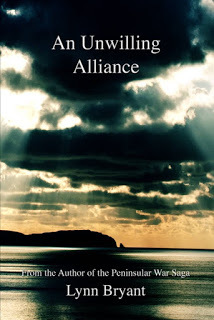 Three of them are from the first book, including Captain Hugh Kelly, who is the Manxman of the title, his wife Roseen and his first officer, Lieutenant Alfred Durrell. There are two army men, Giles Fenwick, who later appears in the Peninsular War Saga and Ross Mackenzie, a new character and there is also a Dutchwoman, Katja de Groot. All the characters bring something different to the story, but if I had to make a choice, I would unhesitatingly say that this book belongs to Durrell.
Three of them are from the first book, including Captain Hugh Kelly, who is the Manxman of the title, his wife Roseen and his first officer, Lieutenant Alfred Durrell. There are two army men, Giles Fenwick, who later appears in the Peninsular War Saga and Ross Mackenzie, a new character and there is also a Dutchwoman, Katja de Groot. All the characters bring something different to the story, but if I had to make a choice, I would unhesitatingly say that this book belongs to Durrell.Durrell is twenty-five at the start of this book, and has been in the navy since he was a boy. He comes from a family of minor gentry in Kent. Durrell’s father was not wealthy but was fortunate enough to have the patronage of the first Earl of Chatham and then later, after the Earl’s death, of his two sons, the second Earl and William Pitt, the prime minister.
In the late eighteenth and early nineteenth century, patronage was king. Put in it’s simplest terms, political patronage is the appointment of a man to a government post on the basis of partisan loyalty. In the days before Parliamentary reform, when many boroughs were controlled by a local landowner, this could also mean the gift of a seat in the House to a man whose duty it then was to support his patron’s interests.
Durrell’s father had enjoyed the patronage of the Pitt family right from the start of his career. He felt an immense sense of loyalty to the family, and held several different posts under the old Earl and then his sons, ending up working at the Admiralty when the second Earl of Chatham was First Lord of the Admiralty.
Both Henry and Alfred Durrell were helped in the early stages of their career by the Pitt interest. The two brothers went to Harrow, but while Henry fitted in well and enjoyed his schooldays, Alfred was unhappy and it was decided that he should go into the navy. He began his navy career as an ‘officers’ servant’ and worked his way up to midshipman and then to lieutenant. It was necessary to take an examination to become a lieutenant, and we are told had Durrell passed his with ridiculously high marks. From there, he held junior lieutenants posts on several different ships before obtaining the post of first lieutenant aboard the Iris in 1806. He was young for the post, and Hugh Kelly offered it to him on the basis of a letter of recommendation from the Earl of Chatham.
Durrell’s relationship with Kelly is one of the pleasures of writing these books. In the early stages, it seems very unlikely that the two men can be friends. They come from very different backgrounds and have very different personalities. Kelly is Manx, his father held a smallholding near South Barrule and drank himself to death after his landlord evicted him for failing to keep the land in good order. Kelly joined the navy as a volunteer, and worked his way up through the ranks without patronage or privilege to help him. He gained his education through the navy and although these days he is very comfortable mixing with all social classes, he’s aware that some people will always see him as a Manx farm boy.
Durrell, in contrast, comes from a good family who mix in the highest circles. He and his brother were presented at court and he has maintained links with the Pitt family. Despite this, he lacks Kelly’s social confidence. He is tall and slim, with the sense that he never knows what to do with his long limbs. We know nothing about his relationships with women, except that his brother teases him about his lack of experience. Durrell likes rules and regulations and has a strong sense of duty and a very good work ethic. He is also brilliant, with a phenomenal memory but in his early days with Hugh, he has no idea when to shut up and his lengthy speeches make Hugh want to thump him. In An Unwilling Alliance , we see Durrell and Hugh getting to know each other and learning to work together. It isn’t easy, and there are times when Hugh wonders if he made a mistake in his choice, but gradually we see the ice thawing and by the time we meet Durrell at the beginning of This Blighted Expedition , Hugh knows his value and is furious when Sir Home Popham manages to get Durrell seconded to him for the duration of the campaign.
Durrell has a very good relationship with Roseen, Hugh’s young wife. They are fairly close in age, although Roseen is often quite maternal towards him, which makes Hugh laugh. Despite Durrell’s shyness around women, he has a younger sister at home, and once he gets to know Roseen, they develop a close friendship which probably helped to smooth out some of the early difficulties between Hugh and Durrell.
Durrell is a serious-minded young man and feels immense loyalty to the Earl of Chatham, the rather ineffectual commander of the army in Walcheren. There is a sense of mutual liking and even affection between them although the relationship is always very formal; Durrell understands the rules of patronage and theirs is not an equal relationship.
During this book, Durrell is away from the Iris for much of the time, acting as aide-de-campto Sir Home Popham. Popham and Durrell met in the first book and their relationship is very complicated. Durrell has huge admiration for Popham’s abilities and is keen to learn from him, but he does not trust him and feels uncomfortable about serving under him.
While Durrell was working his way up the ranks of the navy, his elder brother Henry was appointed to a series of government posts through the Pitt interest, very much as his father was. Unlike his father, Henry is not content with this. He is ambitious and unscrupulous and Durrell quickly realises that there is more to Henry’s appointment to Lord Chatham’s staff during the campaign than meets the eye. In addition, Henry is paying court to Miss Collingwood, the very young daughter of a City merchant and Durrell does not trust his brother’s intentions towards her. As the campaign begins to fall apart, the relationship between Durrell and Henry begins to crumble, revealing tensions that began in boyhood.
A friend who has read This Blighted Expedition, told me that she loved this book because in this campaign, the typical hero-types don’t get much opportunity to be heroic. Instead, the real hero of this book is First Lieutenant Alfred Durrell; awkward, earnest and brilliant. This book is Durrell’s coming-of-age. Durrell started out as a somewhat comic foil to Hugh Kelly and proceeded to steal every scene I’ve ever written him into. I hope my readers come to love him as much as I do.
This Blighted Expedition is available on Amazon kindle here and will be out in paperback by the end of November. To celebrate publication, the first book, An Unwilling Alliance is available from 1st to 5thNovember 2019 FREE on Amazon here.
In the meantime, I am about to embark on book six of the Peninsular War Saga. It’s called An Unrelenting Enmity and to give myself a kick start with the writing process, I am attempting NaNaWriMo for the first time ever. To follow my progress why not join me on my blog over at Writing with Labradors , or on Facebook or Twitter?
Published on November 01, 2019 17:30
October 28, 2019
Things we see every day are invisible
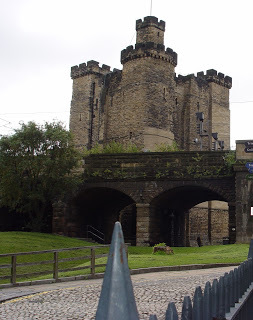 Romans called it Pons Aelius.
Romans called it Pons Aelius.Newcastle has been it name since the Norman conquest of England . I suppose it is my city, since I was born there, though I lived in Durham city from leaving Princes Mary’s until I was seven years old.
In or about AD 120, the Romans built the first bridge to cross the River Tyne. Aelius was the family name of Emperor Hadrian who built a wall across northern England along the Tyne–Solway gap. His wall runs through present-day Newcastle; stretches of wall and turrets exist along the West Road, and various other bits can still be found: a temple in Benwell, a milecastle on Westgate Road, midway between Clayton Street and Grainger Street . The course of the wall corresponded to present day Westgate Road. It runs eastwards to the Segedunum Roman fort at Wallsend, with the fort Arbeia further down river, on the south bank in what is now South Shields.
The Tyne was then a wider, shallower river and the bridge was probably about 700 feet (210m) long, made of wood and supported on stone piers. Probably sited near the current Swing Bridge since Roman artefacts were found there during its building.A shrine was set up on the completed bridge in AD123 by the VIth Legion, with two altars to Neptune and Oceanus respectively. The two altars were subsequently found in the river and are on display in a local museum.
 A stone-walled fort stood on a rocky outcrop overlooking the new bridge, (where the present Castle Keep stands) to protect the river crossing at the foot of the Tyne Gorge. It is believed that there was a Roman cemetery Near Clavering Place, behind the Central station, for a number of Roman coffins have been unearthed there. A small vicus, or village, would likely have grown around the fort but nothing beyond a few pieces of flagging have been found.The Angles arrived in the North-East of England in about AD 500 perhaps landing on the Tyne though there is no evidence of an Anglo-Saxon settlement on or near the site of Pons Aelius. At that time the region was dominated by Bernicia, north of the Tees and ruled from Bamburgh, and Deira, south of the Tees and ruled from York. Bernicia and Deira combined to form the kingdom of Northanhymbra (Northumbria) early in the 7th century.
A stone-walled fort stood on a rocky outcrop overlooking the new bridge, (where the present Castle Keep stands) to protect the river crossing at the foot of the Tyne Gorge. It is believed that there was a Roman cemetery Near Clavering Place, behind the Central station, for a number of Roman coffins have been unearthed there. A small vicus, or village, would likely have grown around the fort but nothing beyond a few pieces of flagging have been found.The Angles arrived in the North-East of England in about AD 500 perhaps landing on the Tyne though there is no evidence of an Anglo-Saxon settlement on or near the site of Pons Aelius. At that time the region was dominated by Bernicia, north of the Tees and ruled from Bamburgh, and Deira, south of the Tees and ruled from York. Bernicia and Deira combined to form the kingdom of Northanhymbra (Northumbria) early in the 7th century.
Three local kings held the title of Bretwalda –Edwin of Deira(627–632), Oswald of Bernicia (633–641) and Oswy of Northumbria (641–658).
The 7th century became known as the 'Golden Age of Northumbria', when the area was a beacon of culture and learning in Europe. The greatness of this period was based on its generally Christian culture and gave birth to the Lindisfarne Gospels. The Tyne valley was dotted with monasteries, with those at Monkwearmouth, Hexham and Jarrow being the most famous. Bede, based at Jarrow, wrote of a royal estate, known as Ad Murum, 'at the Wall', 12 miles (19km) from the sea. This estate may have been in what is now Newcastle.
At some unknown time, Newcastle came to be known as Monkchester though nothing is known of specific monasteries at the site, and Bede made no reference to it. In 875 Halfdan Ragnarsson, the Danish Viking conqueror of York, led an army that attacked and pillaged various monasteries in the area, and it is thought that Monkchester was pillaged at this time. Little more was heard of it until the coming of the Normans.
Published on October 28, 2019 13:46
October 18, 2019
What is a Structural Edit?
I gather what I've been doing in the last few weeks is called Structural Editing
 Untidy but colourfulSome call it Developmental Editing or even Substantive Editing) It has, and is, in my case, taking a long time.
Untidy but colourfulSome call it Developmental Editing or even Substantive Editing) It has, and is, in my case, taking a long time. I console myself with the thought that it is expensive and that many publishers will no longer accept books that need such work. Which automatically means that it is often beyond the budget of a self-publisher.
I have different personalities when it comes to this argument of hiring editors and having them "improve" your book. Part of me thinks the whole thing should be my work. Other parts of me think how wonderful it would be to have someone make these suggestions. I have not yet decided which is my true feeling!
A structural edit isn't beyond the means of a self-published author. It means getting the first two or three drafts done to completion and then leaving it alone for a while. Then go back get out your critical spectacles and look at the whole thing as a reader would. Is the story good, first and foremost? Then does it make sense? Is it believable and satisfying?
At this stage I rearranged one or two scenes to make the sequence flow better. One I brought forward, another I took back; I think I even deleted one totally.
Does your book have themes? Since in this book I'm writing historical romance set in the eleventh century, my themes are the themes of the time. They're very differnet to my Regency and Victorian romances.Then I look at the characters. Are they differentiated from one another? Do they grow and change, or remain static? Have I described them adequately for the reader?
POV sometimes wanders, so I keep an eye on that. Sometimes I change a secene's POV.
Pace is important. Any section that drags for me will drag for the reader. I change it or delete it so that there is (hopefully!) a slow-build up of tension. Pace and flow often run together, so I'm on the look-out for repetition, contradictory plot points, dead-end conversations and unnecessary backstory. Occasionally I've had to include a missing plot-point or a fact that was needed to allowor avoid something further down the line.
Dialogue is important and needs to be succinct, minus clutter (ie adverbs, adjectives) and still take the plot forward. I like humour in my dialogue when I can get it, too.
Finally I'd add Voice. Different books, different plots, different characters all require a voice that is unique to them. I spend some time considering my POV character's tone of voice, how s/he sees life and try and get this into their thoughts and dialogue.
If you are happy with your story after all that, then perhaps you've just completed a Structural Edit
·
Published on October 18, 2019 02:42
October 11, 2019
Wonderful Northern Castles
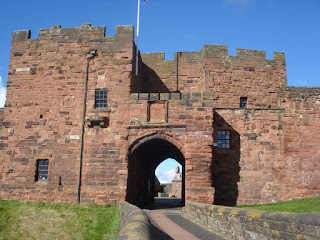
We're not short of castles in the north of England.
This is Carlisle, about 60 miles west of Newcastle and virtually the capital of the Borderlands during the three centuries of the Border Reivers.
It is first and foremost a defensive castle to hold back raids and armies from Scotland. It sits almost on the border line and many a Scots prisoner was brought to Carlisle's dungeons.
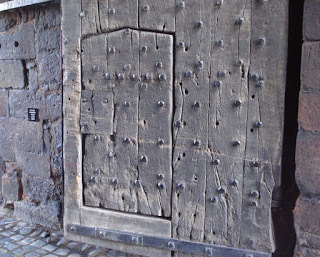
There are fascinating wall carvings where Tudor prisoners prisoners whiled away their time leaving their names and insignia for all to see. The castle featured as the headquarters of Sir Thomas Wharton in my book Abduction of the Scots Queen and as I wrote I had so many pictures of the castle in my mind from the huge portcullis to the tiny little snickert door cut into the larger one.
I am now wondering if I have misremembered the term snickert as I cannot find it in the etymological dictionary. I don't mean a postern gate; that is something quite different. If anyone can confirm or deny, please do! This is now going to worry me until I find the right answer!
Published on October 11, 2019 02:03
October 8, 2019
If you are interested in Gibside, then try this link:http...
If you are interested in Gibside, then try this link:
https://www.nationaltrust.org.uk/gibside/features/gibside-a-grand-estate
It tells of the estate and the disastrous marriage that ruined it.


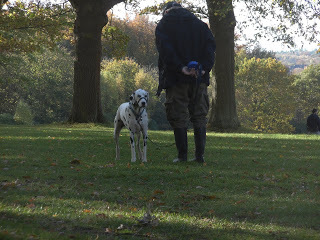
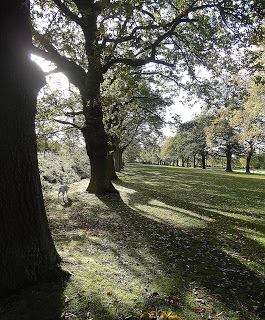
https://www.nationaltrust.org.uk/gibside/features/gibside-a-grand-estate
It tells of the estate and the disastrous marriage that ruined it.




Published on October 08, 2019 02:27
October 6, 2019
Wet Weather Walk
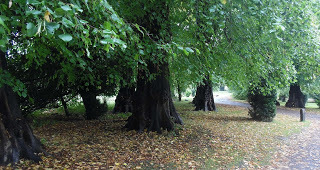 Yesterday we took Tim for a walk at Gibside, a National Trust estate once owned by the Bowes-Lyon family.
Yesterday we took Tim for a walk at Gibside, a National Trust estate once owned by the Bowes-Lyon family.Their money was made on coal, mined from the surrounding landscape. The long flat stretch from the chapel to where the road curves round in front of the house and the dip down the hillside is where the racehorses were exercised.
The weather was dismal but meant we had the place to ourselves. Away in the distance we saw the clutch of pre-school children doggedly scrambling after their leader through the sudden downpour which didn't seem to dampen their spirits at all.
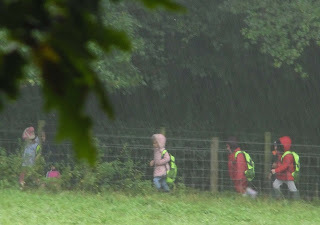
The low cloud base meant that the column of Liberty can barely be seen at the far end of the long drive, but perhaps if you click on the pic, you'll spot it on the larger version!
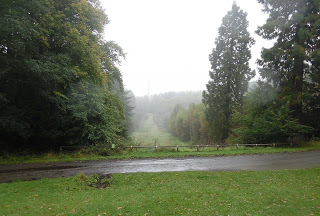
Published on October 06, 2019 03:56
Jen Black's Blog
- Jen Black's profile
- 6 followers
Jen Black isn't a Goodreads Author
(yet),
but they
do have a blog,
so here are some recent posts imported from
their feed.



